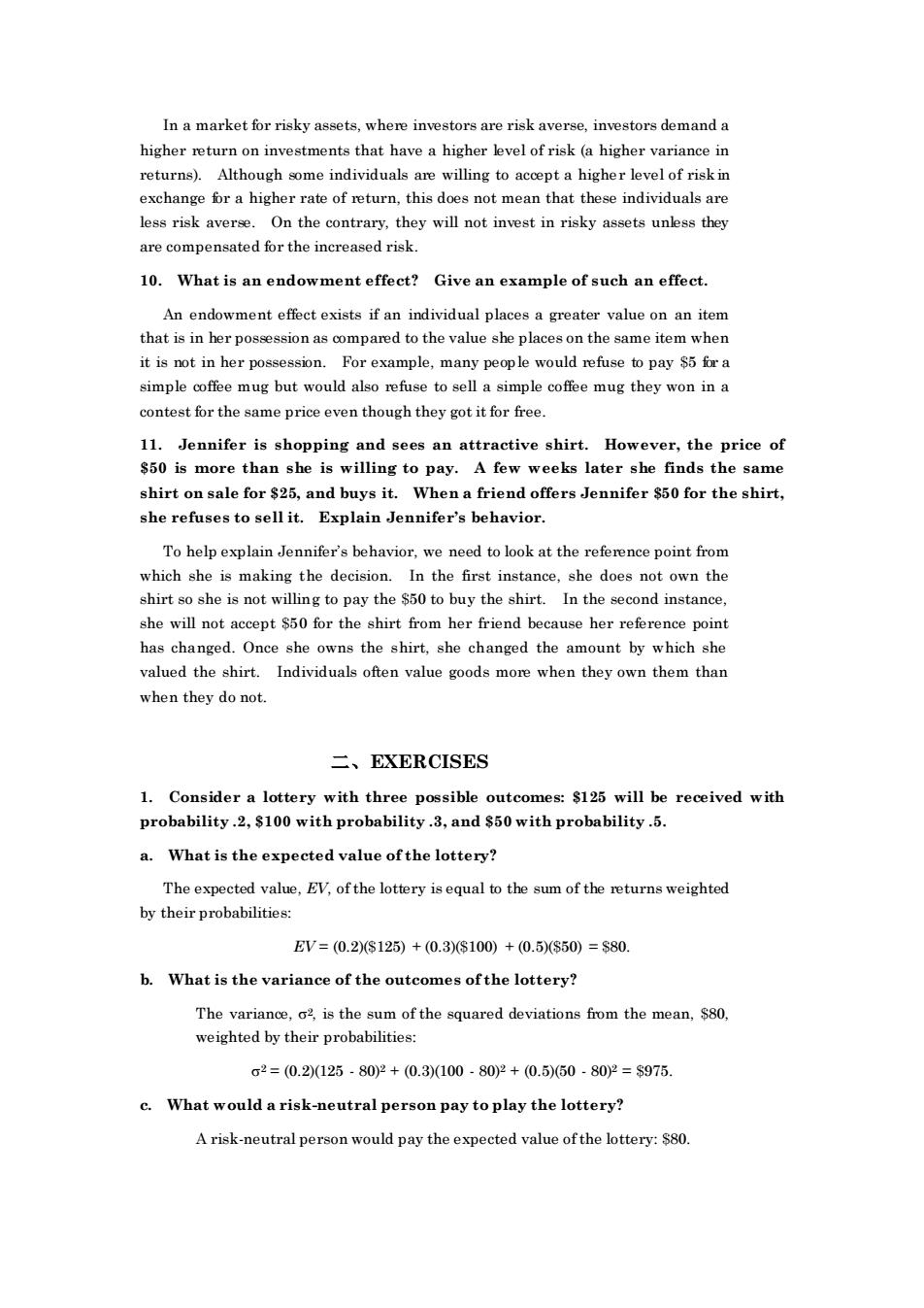正在加载图片...

In a market for risky assets.where investors are risk averse,investors demand a on investments that have a higher evel of risk(a higher variance in returns). Although some individuals are willing to accept a higher level of risk in exchange for a higher rate of return,this does not mean that these individuals are less risk averse.On the contrary.they will not invest in risky assets unkess they are compensated for the increased risk. 10.What is an endowment effect?Give an example of such an effect. An endowment effect exists if an individual places a greater value on an item to the value she pac onthe same item when it is not in her or example,many people would refuse topay$5 simple coffee mug but would also refuse to sell a simple coffee mug they won in a contest for the same price even though they got it for free. 11.Jennifer is shopping and sees an attractive shirt.However,the price of $50 is more than she is willing to pay.A few weeks later she finds the same shirt on sale for $25,and buys it.When a friend offers Jennifer $50 for the shirt, she refuses to sell it. Explain Jennifer's behavior To help explain Jennifers behavior,we need to look at the reference point from which she is making the decision.In the first instance.she does not own the shirt so she is not willing to pay the $50 to buy the shirt.In the second instance. she will not accept $50 for the shirt from her friend because her reference point has changed.Once she owns the shirt.she changed the amount by which she valued the shirt.Individuals often value goods more when they own them than when they do not 二、EXERCISES 1.Consider a lottery with three possible outcomes:$125 will be received with probability.2,$100 with probability.3,and $50 with probability.5. a.What is the expected value ofthe lottery? The expected value,EV,of the lottery isequal to the sum of the returns weighted by their probabilities: EV=(0.2)$125)+(0.3)$100)+(0.5)$50)=$80 b.What is the variance of the outcomes ofthe lottery? The variance,is the sum of the squared deviations from the mean.$80. weighted by their probabilities 2=(0.2125.802+(0.3100.80+(0.560.80y=$975. c What would a risk-neutral person pay to play the lottery? Arisk-neutral person would pay the expected value ofthe lottery:$8 In a market for risky assets, where investors are risk averse, investors demand a higher return on investments that have a higher level of risk (a higher variance in returns). Although some individuals are willing to accept a higher level of risk in exchange for a higher rate of return, this does not mean that these individuals are less risk averse. On the contrary, they will not invest in risky assets unless they are compensated for the increased risk. 10. What is an endowment effect? Give an example of such an effect. An endowment effect exists if an individual places a greater value on an item that is in her possession as compared to the value she places on the same item when it is not in her possession. For example, many people would refuse to pay $5 for a simple coffee mug but would also refuse to sell a simple coffee mug they won in a contest for the same price even though they got it for free. 11. Jennifer is shopping and sees an attractive shirt. However, the price of $50 is more than she is willing to pay. A few weeks later she finds the same shirt on sale for $25, and buys it. When a friend offers Jennifer $50 for the shirt, she refuses to sell it. Explain Jennifer’s behavior. To help explain Jennifer’s behavior, we need to look at the reference point from which she is making the decision. In the first instance, she does not own the shirt so she is not willing to pay the $50 to buy the shirt. In the second instance, she will not accept $50 for the shirt from her friend because her reference point has changed. Once she owns the shirt, she changed the amount by which she valued the shirt. Individuals often value goods more when they own them than when they do not. 二、EXERCISES 1. Consider a lottery with three possible outcomes: $125 will be received with probability .2, $100 with probability .3, and $50 with probability .5. a. What is the expected value of the lottery? The expected value, EV, of the lottery is equal to the sum of the returns weighted by their probabilities: EV = (0.2)($125) + (0.3)($100) + (0.5)($50) = $80. b. What is the variance of the outcomes of the lottery? The variance, 2, is the sum of the squared deviations from the mean, $80, weighted by their probabilities: 2 = (0.2)(125 - 80)2 + (0.3)(100 - 80)2 + (0.5)(50 - 80)2 = $975. c. What would a risk-neutral person pay to play the lottery? A risk-neutral person would pay the expected value of the lottery: $80